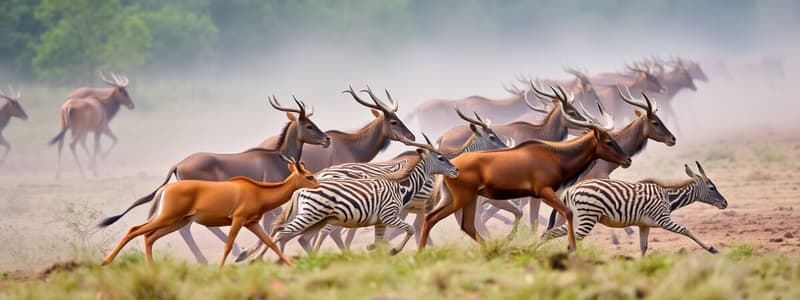Podcast
Questions and Answers
What is a primary reason animals engage in migration?
What is a primary reason animals engage in migration?
- To adapt to climate changes year-round
- To find food or raise their young (correct)
- To explore new habitats
- To escape from predators
How do most migrating animals navigate during their journeys?
How do most migrating animals navigate during their journeys?
- Through systematic mapping and environmental cues
- By instinct and relying on memory of previous routes (correct)
- Using celestial navigation techniques
- By following geographical landmarks only
Which of the following best explains why many animals migrate to northern regions during summer?
Which of the following best explains why many animals migrate to northern regions during summer?
- To escape increased temperatures in their original habitats
- To avoid competition with other species
- To benefit from long summer days providing ample food (correct)
- To follow specific breeding cycles dictated by lunar phases
In which season do most animals migrate south?
In which season do most animals migrate south?
What distance can some migrating sea creatures, like the grey whale, travel?
What distance can some migrating sea creatures, like the grey whale, travel?
Flashcards are hidden until you start studying
Study Notes
Overview of Animal Migration
- Migration refers to the movement of animals from their home territory to another location and back.
- Many migrations are cyclical, occurring at specific times of the year.
Reasons for Migration
- Animals migrate primarily to search for food or to give birth to their young.
- Some species exhibit strong fidelity to migration routes, repeating the journey annually and passing knowledge to subsequent generations.
Types of Migratory Behaviors
- Land animals often navigate challenging terrains such as mountains and rivers.
- Birds and insects can cover vast distances, occasionally migrating between continents and oceans.
- Aquatic species, including fish, may travel significant distances, such as the grey whale, which can migrate up to 20,000 kilometers.
Seasonal Patterns of Migration
- Many species head north during summer months to take advantage of abundant food resources due to extended daylight.
- As autumn approaches and temperatures drop, numerous animals migrate southward in search of food and milder weather, aligning with the southern summer.
Migration Frequency
- Certain animals undertake both northward and southward migrations within a single year.
- Other species may have less frequent migratory patterns, embarking on the journey less often than annually.
Studying That Suits You
Use AI to generate personalized quizzes and flashcards to suit your learning preferences.





